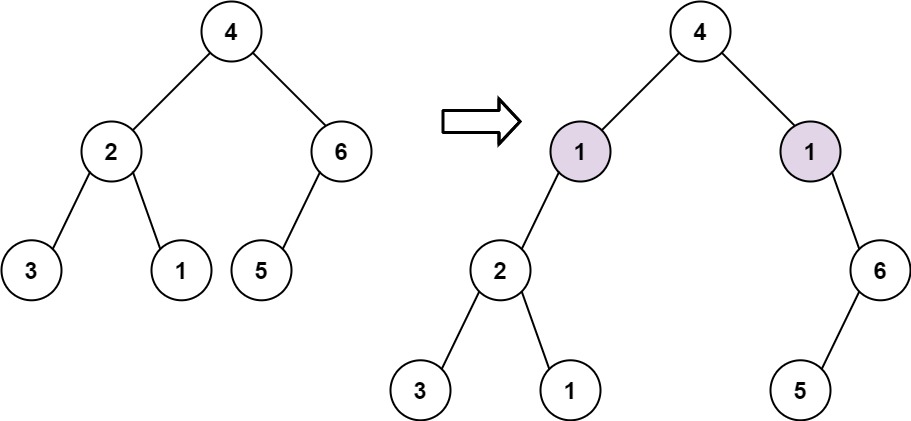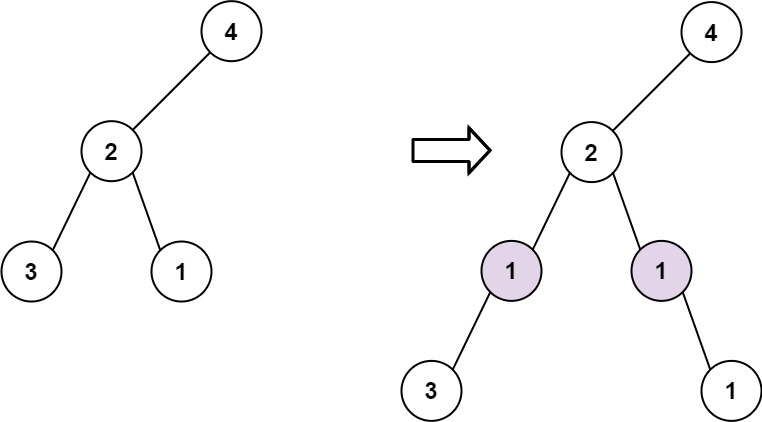给定一个二叉树的根 root 和两个整数 val 和 depth ,在给定的深度 depth 处添加一个值为 val 的节点行。
注意,根节点 root 位于深度 1 。
加法规则如下:
- 给定整数
depth,对于深度为 depth - 1 的每个非空树节点 cur ,创建两个值为 val 的树节点作为 cur 的左子树根和右子树根。
cur 原来的左子树应该是新的左子树根的左子树。cur 原来的右子树应该是新的右子树根的右子树。- 如果
depth == 1 意味着 depth - 1 根本没有深度,那么创建一个树节点,值 val 作为整个原始树的新根,而原始树就是新根的左子树。
示例 1:

**输入:** root = [4,2,6,3,1,5], val = 1, depth = 2
**输出:** [4,1,1,2,null,null,6,3,1,5]
示例 2:

**输入:** root = [4,2,null,3,1], val = 1, depth = 3
**输出:** [4,2,null,1,1,3,null,null,1]
提示:
- 节点数在
[1, 104] 范围内
- 树的深度在
[1, 104]范围内
-100 <= Node.val <= 100-105 <= val <= 1051 <= depth <= the depth of tree + 1
方法一:深度优先搜索
思路
当输入 depth 为 1 时,需要创建一个新的 root,并将原 root 作为新 root 的左子节点。当 depth 为 2 时,需要在 root 下新增两个节点 left 和 right 作为 root 的新子节点,并把原左子节点作为 left 的左子节点,把原右子节点作为 right 的右子节点。当 depth 大于 2 时,需要继续递归往下层搜索,并将 depth 减去 1,直到搜索到 depth 为 2。
代码
[sol1-Python3]1
2
3
4
5
6
7
8
9
10
11
12
13
| class Solution:
def addOneRow(self, root: TreeNode, val: int, depth: int) -> TreeNode:
if root == None:
return
if depth == 1:
return TreeNode(val, root, None)
if depth == 2:
root.left = TreeNode(val, root.left, None)
root.right = TreeNode(val, None, root.right)
else:
root.left = self.addOneRow(root.left, val, depth - 1)
root.right = self.addOneRow(root.right, val, depth - 1)
return root
|
[sol1-Java]1
2
3
4
5
6
7
8
9
10
11
12
13
14
15
16
17
18
| class Solution {
public TreeNode addOneRow(TreeNode root, int val, int depth) {
if (root == null) {
return null;
}
if (depth == 1) {
return new TreeNode(val, root, null);
}
if (depth == 2) {
root.left = new TreeNode(val, root.left, null);
root.right = new TreeNode(val, null, root.right);
} else {
root.left = addOneRow(root.left, val, depth - 1);
root.right = addOneRow(root.right, val, depth - 1);
}
return root;
}
}
|
[sol1-C#]1
2
3
4
5
6
7
8
9
10
11
12
13
14
15
16
17
18
| public class Solution {
public TreeNode AddOneRow(TreeNode root, int val, int depth) {
if (root == null) {
return null;
}
if (depth == 1) {
return new TreeNode(val, root, null);
}
if (depth == 2) {
root.left = new TreeNode(val, root.left, null);
root.right = new TreeNode(val, null, root.right);
} else {
root.left = AddOneRow(root.left, val, depth - 1);
root.right = AddOneRow(root.right, val, depth - 1);
}
return root;
}
}
|
[sol1-C++]1
2
3
4
5
6
7
8
9
10
11
12
13
14
15
16
17
18
19
| class Solution {
public:
TreeNode* addOneRow(TreeNode* root, int val, int depth) {
if (root == nullptr) {
return nullptr;
}
if (depth == 1) {
return new TreeNode(val, root, nullptr);
}
if (depth == 2) {
root->left = new TreeNode(val, root->left, nullptr);
root->right = new TreeNode(val, nullptr, root->right);
} else {
root->left = addOneRow(root->left, val, depth - 1);
root->right = addOneRow(root->right, val, depth - 1);
}
return root;
}
};
|
[sol1-C]1
2
3
4
5
6
7
8
9
10
11
12
13
14
15
16
17
18
19
20
21
22
23
24
25
26
27
28
29
| struct TreeNode* addOneRow(struct TreeNode* root, int val, int depth) {
if (root == NULL) {
return NULL;
}
struct TreeNode *node = (struct TreeNode *)malloc(sizeof(struct TreeNode));
if (depth == 1) {
node = (struct TreeNode *)malloc(sizeof(struct TreeNode));
node->val = val;
node->left = root;
node->right = NULL;
return node;
}
if (depth == 2) {
node = (struct TreeNode *)malloc(sizeof(struct TreeNode));
node->val = val;
node->left = root->left;
node->right = NULL;
root->left = node;
node = (struct TreeNode *)malloc(sizeof(struct TreeNode));
node->val = val;
node->left = NULL;
node->right = root->right;
root->right = node;
} else {
root->left = addOneRow(root->left, val, depth - 1);
root->right = addOneRow(root->right, val, depth - 1);
}
return root;
}
|
[sol1-JavaScript]1
2
3
4
5
6
7
8
9
10
11
12
13
14
15
16
| var addOneRow = function(root, val, depth) {
if (!root) {
return null;
}
if (depth === 1) {
return new TreeNode(val, root, null);
}
if (depth === 2) {
root.left = new TreeNode(val, root.left, null);
root.right = new TreeNode(val, null, root.right);
} else {
root.left = addOneRow(root.left, val, depth - 1);
root.right = addOneRow(root.right, val, depth - 1);
}
return root;
};
|
[sol1-Golang]1
2
3
4
5
6
7
8
9
10
11
12
13
14
15
16
| func addOneRow(root *TreeNode, val, depth int) *TreeNode {
if root == nil {
return nil
}
if depth == 1 {
return &TreeNode{val, root, nil}
}
if depth == 2 {
root.Left = &TreeNode{val, root.Left, nil}
root.Right = &TreeNode{val, nil, root.Right}
} else {
root.Left = addOneRow(root.Left, val, depth-1)
root.Right = addOneRow(root.Right, val, depth-1)
}
return root
}
|
复杂度分析
方法二:广度优先搜索
思路
与深度优先搜索类似,我们用广度优先搜索找到要加的一行的上一行,然后对这一行的每个节点 node,都新增两个节点 left 和 right 作为 node 的新子节点,并把原左子节点作为 left 的左子节点,把原右子节点作为 right 的右子节点。
代码
[sol2-Python3]1
2
3
4
5
6
7
8
9
10
11
12
13
14
15
16
17
| class Solution:
def addOneRow(self, root: TreeNode, val: int, depth: int) -> TreeNode:
if depth == 1:
return TreeNode(val, root, None)
curLevel = [root]
for _ in range(1, depth - 1):
tmpt = []
for node in curLevel:
if node.left:
tmpt.append(node.left)
if node.right:
tmpt.append(node.right)
curLevel = tmpt
for node in curLevel:
node.left = TreeNode(val, node.left, None)
node.right = TreeNode(val, None, node.right)
return root
|
[sol2-Java]1
2
3
4
5
6
7
8
9
10
11
12
13
14
15
16
17
18
19
20
21
22
23
24
25
26
| class Solution {
public TreeNode addOneRow(TreeNode root, int val, int depth) {
if (depth == 1) {
return new TreeNode(val, root, null);
}
List<TreeNode> curLevel = new ArrayList<TreeNode>();
curLevel.add(root);
for (int i = 1; i < depth - 1; i++) {
List<TreeNode> tmpt = new ArrayList<TreeNode>();
for (TreeNode node : curLevel) {
if (node.left != null) {
tmpt.add(node.left);
}
if (node.right != null) {
tmpt.add(node.right);
}
}
curLevel = tmpt;
}
for (TreeNode node : curLevel) {
node.left = new TreeNode(val, node.left, null);
node.right = new TreeNode(val, null, node.right);
}
return root;
}
}
|
[sol2-C#]1
2
3
4
5
6
7
8
9
10
11
12
13
14
15
16
17
18
19
20
21
22
23
24
25
26
| public class Solution {
public TreeNode AddOneRow(TreeNode root, int val, int depth) {
if (depth == 1) {
return new TreeNode(val, root, null);
}
IList<TreeNode> curLevel = new List<TreeNode>();
curLevel.Add(root);
for (int i = 1; i < depth - 1; i++) {
IList<TreeNode> tmpt = new List<TreeNode>();
foreach (TreeNode node in curLevel) {
if (node.left != null) {
tmpt.Add(node.left);
}
if (node.right != null) {
tmpt.Add(node.right);
}
}
curLevel = tmpt;
}
foreach (TreeNode node in curLevel) {
node.left = new TreeNode(val, node.left, null);
node.right = new TreeNode(val, null, node.right);
}
return root;
}
}
|
[sol2-C++]1
2
3
4
5
6
7
8
9
10
11
12
13
14
15
16
17
18
19
20
21
22
23
24
25
26
| class Solution {
public:
TreeNode* addOneRow(TreeNode* root, int val, int depth) {
if (depth == 1) {
return new TreeNode(val, root, nullptr);
}
vector<TreeNode *> curLevel(1, root);
for (int i = 1; i < depth - 1; i++) {
vector<TreeNode *> tmpt;
for (auto &node : curLevel) {
if (node->left != nullptr) {
tmpt.emplace_back(node->left);
}
if (node->right != nullptr) {
tmpt.emplace_back(node->right);
}
}
curLevel = move(tmpt);
}
for (auto &node : curLevel) {
node->left = new TreeNode(val, node->left, nullptr);
node->right = new TreeNode(val, nullptr, node->right);
}
return root;
}
};
|
[sol2-C]1
2
3
4
5
6
7
8
9
10
11
12
13
14
15
16
17
18
19
20
21
22
23
24
25
26
27
28
29
30
31
32
33
34
35
36
37
38
39
40
| #define MAX_NODE_SIZE 10000
struct TreeNode* addOneRow(struct TreeNode* root, int val, int depth) {
struct TreeNode* node = NULL;
if (depth == 1) {
node = (struct TreeNode *)malloc(sizeof(struct TreeNode));
node->val = val;
node->left = root;
node->right = NULL;
return node;
}
struct TreeNode **queue = (struct TreeNode **)malloc(sizeof(struct TreeNode *) * MAX_NODE_SIZE);
int head = 0, tail = 0;
queue[tail++] = root;
for (int i = 1; i < depth - 1; i++) {
int sz = tail - head;
for (int j = 0; j < sz; j++) {
if (queue[head]->left != NULL) {
queue[tail++] = queue[head]->left;
}
if (queue[head]->right != NULL) {
queue[tail++] = queue[head]->right;
}
head++;
}
}
for (; head != tail; head++) {
node = (struct TreeNode *)malloc(sizeof(struct TreeNode));
node->val = val;
node->left = queue[head]->left;
node->right = NULL;
queue[head]->left = node;
node = (struct TreeNode *)malloc(sizeof(struct TreeNode));
node->val = val;
node->left = NULL;
node->right = queue[head]->right;
queue[head]->right = node;
}
return root;
}
|
[sol2-JavaScript]1
2
3
4
5
6
7
8
9
10
11
12
13
14
15
16
17
18
19
20
21
22
23
24
| var addOneRow = function(root, val, depth) {
if (depth === 1) {
return new TreeNode(val, root, null);
}
let curLevel = [];
curLevel.push(root);
for (let i = 1; i < depth - 1; i++) {
const tmp = [];
for (const node of curLevel) {
if (node.left) {
tmp.push(node.left);
}
if (node.right) {
tmp.push(node.right);
}
}
curLevel = tmp;
}
for (const node of curLevel) {
node.left = new TreeNode(val, node.left, null);
node.right = new TreeNode(val, null, node.right);
}
return root;
};
|
[sol2-Golang]1
2
3
4
5
6
7
8
9
10
11
12
13
14
15
16
17
18
19
20
21
22
23
| func addOneRow(root *TreeNode, val, depth int) *TreeNode {
if depth == 1 {
return &TreeNode{val, root, nil}
}
nodes := []*TreeNode{root}
for i := 1; i < depth-1; i++ {
tmp := nodes
nodes = nil
for _, node := range tmp {
if node.Left != nil {
nodes = append(nodes, node.Left)
}
if node.Right != nil {
nodes = append(nodes, node.Right)
}
}
}
for _, node := range nodes {
node.Left = &TreeNode{val, node.Left, nil}
node.Right = &TreeNode{val, nil, node.Right}
}
return root
}
|
复杂度分析

